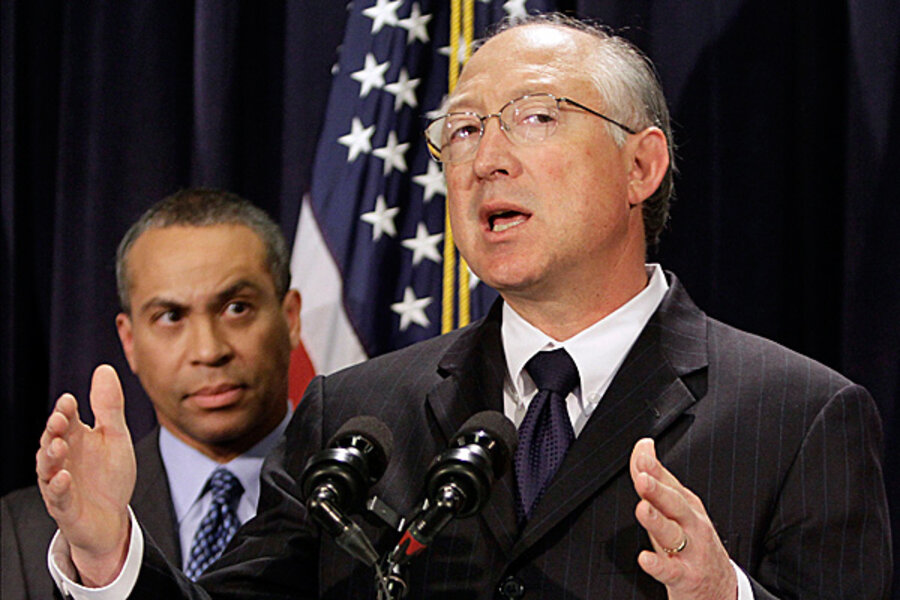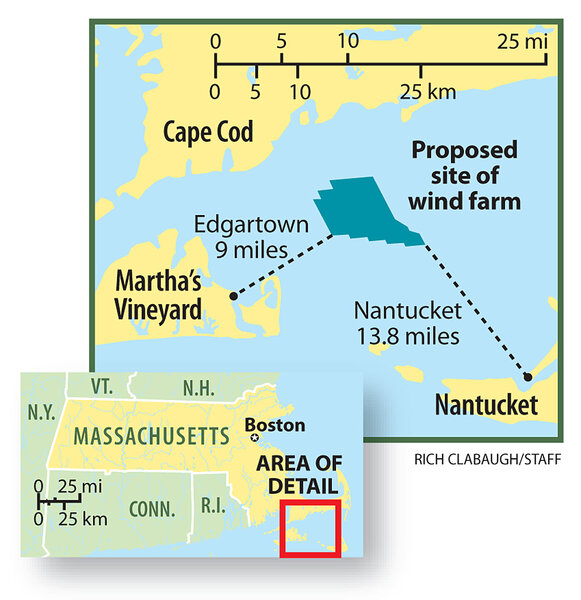Cape Wind project approved
The long-embattled Cape Wind project won federal approval today, marking a major step toward becoming the first US offshore wind-power project and paving the way for a new source of renewable energy for America.
For nearly a decade, regulatory battles have pitted residents of Massachusetts' cape and islands, Indian tribes, and influential politicians against one another and developers of the project. Secretary of the Interior Ken Salazar gave the green light for the project Wednesday at the Massachusetts Statehouse with Gov. Deval Patrick at his side.
“After careful consideration of all the concerns expressed during the lengthy review and consultation process and thorough analyses of the many factors involved, I find that the public benefits weigh in favor of approving the Cape Wind project at the Horseshoe Shoal location,” Mr. Salazar said. “With this decision, we are beginning a new direction in our nation’s energy future, ushering in America’s first offshore wind-energy facility and opening a new chapter in the history of this region.”
IN PICTURES: The answer is blowing in the wind
A smaller project with some restrictions on it
But Salazar also noted that the project would be scaled back from its original 170 turbines to 130 and undergo special requirements – including requiring additional archeological research offshore to ensure that native sacred areas are protected.
The project, which will put the 440-foot-high turbines across a 24-square-mile swath of Nantucket Sound, is expected to provide Massachusetts residents with an average output of about 180 megawatts of power, enough renewable energy to power about 75 percent of the homes on Cape Cod, Martha’s Vineyard, and Nantucket.
The elimination of some turbines would reduce the visual impacts from the Kennedy Compound National Historic Landmark, and the array of turbines would be moved farther from Nantucket Island to curb visibility from the Nantucket Historic District.
Regarding possible seabed cultural and historic resources, the developer would be required to halt operations and notify the government of any surprise archaeological find.
“Impacts to the historic properties can and will be minimized and mitigated, and we will ensure that cultural resources will not be harmed or destroyed during the construction, maintenance, and decommissioning of the project," Salazar said.
A big factor in his decision, Salazar told reporters, was a recent letter by governors of Northeast coastal states, which protested a federal historic panel's verdict that recommended that the project not be approved. If that advice were followed, the governors noted, most wind project proposals up and down the East Coast probably could not go forward.
This would be America's first offshore wind power
After lagging European nations that have already rolled out huge offshore wind farms, Salazar's OK was a critical step smoothing the way for offshore wind industry to begin development in the US, according to Governor Patrick, who thanked Salazar for his decision.
"America needs offshore wind power," Patrick said. "The US is 20 years behind Europe, and China is pulling ahead." The project, he said, is already bringing new jobs to the state, citing a new wind-blade turbine test facility and a turbine manufacturer, Siemens, that would locate in the Bay State. "If we get clean energy right, the whole world will be our customer."
Some energy industry analysts agreed.
"This is a very symbolic step for the offshore wind industry," says Matt Kaplan, a senior wind industry analyst at IHS Emerging Energy Research in Cambridge, Mass. "Cape Wind has been the offshore wind pioneer in the US. If the project is completed, it would signal the beginning of a new industry in the US."
The move, however, is likely to displease the family of the late Sen. Ted Kennedy, whose property overlooks the seascape where the wind turbines will be built. They have long opposed the project.
But Sen. John Kerry (D) of Mass. has indicated that he will support it..
On Monday, the Aquinnah Wampanoag Tribe on Martha's Vineyard announced that it would file suit if Salazar approved the project. The group has said wind turbines would disturb a region sacred to it.
Others were also phoning their lawyers. "We're absolutely taking legal action," says Patty Dineen, a spokesman for the Alliance to Protect Nantucket Sound.
Responding to reporters' questions, Salazar said he was confident that his decision – backed up by nine years of environmental and other reviews – would hold up in court: "There's no question in my mind that the review has been thorough."
While US wind energy resources are massive, most are on land in the wind-swept Plains states. There are already more than 35,000 megawatts of land-based wind power in America today – but none offshore.
Much potential in offshore wind power
The National Renewable Energy Laboratory has projected that 90,000 megawatts of power could be had in shallow US waters alone.
A Department of Energy study found that the US could generate 20 percent of its electricity from wind energy – about 300,000 megawatts. Of that total, about one-sixth – or 54,000 megawatts of capacity – could come from offshore wind.
For many environmentalists, the approval of the project was a big step in the fight against global warming, substituting wind for fossil fuel-based energy.
"It's going to have a huge impact," says Sean Garren, a spokesman for Environment America. "Some of the best wind resources in the country are off our shores. We need to get going harnessing those clean resources."
IN PICTURES: The answer is blowing in the wind
Editor's Note: The original article misstated the number of megawatts of land-based wind power in the United States today.






